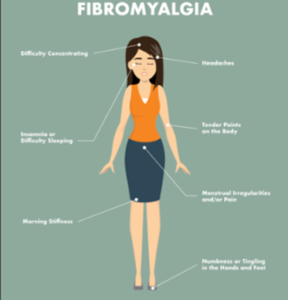Fibromyalgia is a chronic pain condition which causes body aches, muscle pain and tenderness all over the body, it is commonly accompanied by symptoms such as fatigue, emotional distress, cognitive disturbances, reduced mental clarity and a raft of other symptoms. Changes in the central nervous system are the leading cause of fibromyalgia, these changes usually develop in middle adulthood and affects more women than men. Fibromyalgia affects 2 – 5% of the Australian population.
Many people with fibromyalgia worry that exercise will make their symptoms worse. But this statement is in fact wrong! It has been proven that exercise is the most effective treatment for fibromyalgia and the current exercise treatment is centred around gradual, progressive increases in movement and activity that is well tolerated by the person being treated.
Benefits of exercise:
Exercise provides huge improvements and benefits for people living with fibromyalgia. These include:
- Improved energy levels.
- Improved mental health and wellbeing.
- Improved sleep time and quality.
- Increased over health and fitness.
- Increased ability to perform everyday tasks.
- Reduced pain and number of painful areas.
Where to start:
For people living with fibromyalgia the thought of exercise may be daunting and feel out of reach. This is why the best place to start would be seeking help from an Exercise Physiologist. They understand that walking to the mailbox or doing daily housework may be so exhausting for some people, they will work with the person they are treating to build an individualised exercise program to suit all needs and abilities. The key with exercise is that should start slowly and progress steadily.
Exercise ideas:
Hydrotherapy: People with fibromyalgia would benefit from attend hydrotherapy exercise sessions as they are non-weight bearing due to the water supporting their body which allows pain free movement. The warmth of the water is an added benefit that allows tight muscles to relax.
Pilates: Strengthening the hips, glutes and lower limb muscles is important for people with fibromyalgia. Pilates style exercises such as glute bridges help with strengthening the above areas which in turn helps with everyday tasks like getting out of a chair or picking something up off the floor. Pilates style exercise allows for gentle full body exercise which is easy to cope with.
Walking: Regular aerobic exercise is beneficial for everyone as it improves our cardiovascular fitness. Walking is an easy exercise that can be modified to suit all needs and abilities. Starting with a short walk to and from the mailbox everyday can make huge improvements in overall fitness and reduce pain levels while also improving sleep quality.
Conclusion:
People living with fibromyalgia can become overwhelmed with pain very quickly due to over stimulation on their nervous system, even minimal activity can cause a large spike in pain. When exercising you shouldn’t push through the pain when living with fibromyalgia as this will build a barrier to exercise and the brain will send signals refusing to exercise. You want to start slowly and not push towards maximal exercise too quickly. Daily movement and exercise are the best medicines for people living with fibromyalgia.




